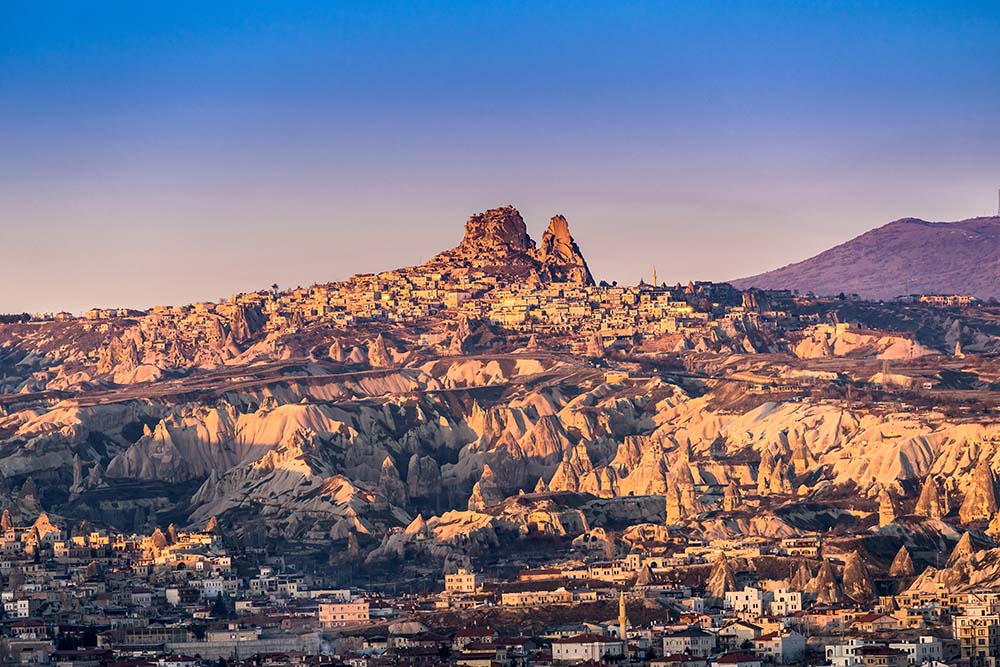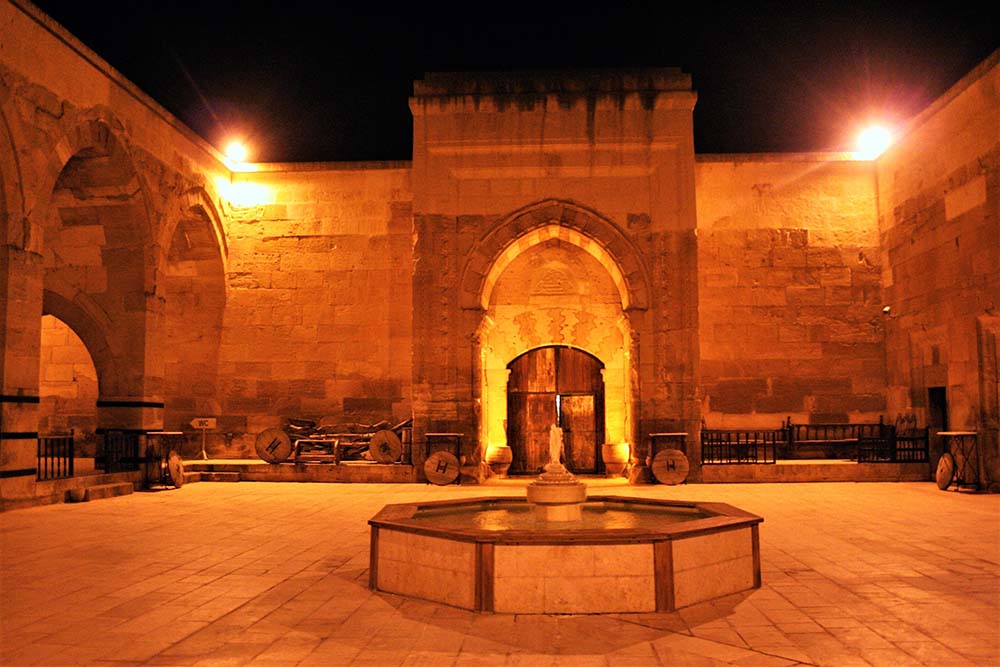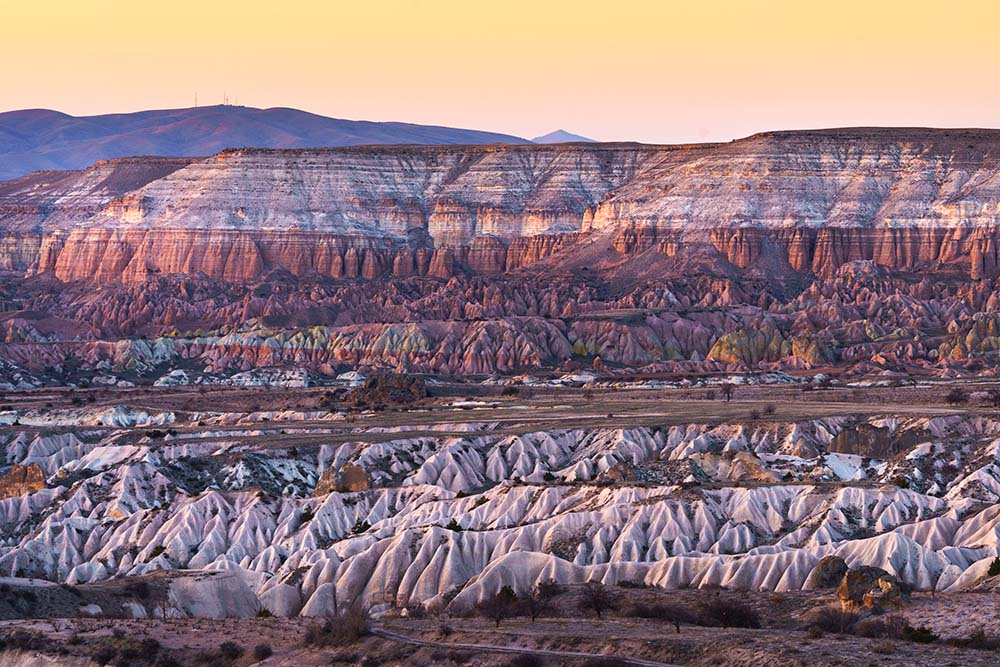Cappadocia is one of the most beautiful places in Turkey that manages to integrate history and nature. It offers unique travel possibilities with its cultural, natural, and historical traces. Cappadocia shows the mysterious side to not only visitors from Turkey, but also visitors from all around the world. The Cappadocia region emerged thanks to the erosion of soft layers formed by the combination of lava and ashes erupted from mountains millions of years ago. These lands were used as an important center in the Christian world during the early periods of Christianity. Churches carved in rocks and houses were also used as shelters.
The caves in Cappadocia are not just simple caves. They are also underground cities that carry mysterious secrets of the past. The tuffs could be used as a shelter, because these rock structures were soft enough for carving. People were using these areas as a defense mechanism when they discovered that the rocks could easily be excavated and expanded. The sections in the underground cities thus host hundreds of rooms. Low, narrow, and long galleries were designed to help hide from the enemy. This underground living areas consist of cellars, kitchens, stables, and worship places. Apart from that, there were ventilation and water wells in the rooms, so that daily life could be sustained in these areas. Today, there are known to be around 40 Cappadocia underground cities. However, according to historical research, it is thought that Cappadocia and its vicinity actually had at one time about 200 underground cities. The reliefs of the Hittites that date back to 2,000s BC proved how much underground cities bear traces of a historical past.
Kaymaklı Underground City
The history of the Kaymaklı Underground City dates to 8th. Century BC and presents the history of the Phrygian period. This underground city is located in Kaymaklı Town of Cappadocia, Nevşehir. The underground city in Kaymaklı Town has been on the UNESCO World Heritage List since 1984. There are known to be 8 floors but only 4 of them are open for visitors. The first floor was prepared for the animals so it is basically a barn. Corridors were open paths to churches and other living areas. When you enter the church, you see the tombstones and church officials’ items. There is a shrine, a reception area, an eating area, and a seating area on the 3rd and 4th floors. Another interesting detail is the copper workshop where you watch different methods of copper workmanship in action. It is thought that this underground city is connected to the Derinkuyu Underground City in Cappadocia; however, there has not been any evidence to confirm this. We can say that the Kaymaklı Underground City was one of the most crowded cities and about 5,000 people could live there.

Cappadocia in the morning.
Derinkuyu Underground City
One of the most interesting and amazing underground cities of Cappadocia is Derinkuyu Underground City. This area was discovered in 1963 and opened in 1967. Have you ever tried to go down 50 floors below ground before? If not, 8 floors are waiting for you with all the mystery. Just 8 floors are open for visitors. According to research, there are 52 water wells. The water had to be removed from the wells because there was no surface connection in the old era. It is thought that about 50,000 people had lived in this city which consists of protected areas and natural ventilation areas.
Sivas Gökçetoprak Underground City
Discovered in 1989 by French researchers, it is thought that this city is made up of 2 floors. The rooms were discovered as uneven rectangular carved structures. The corridors’ entrances were closed with rock gates. Today, there is still a 15-meter water well, with water in it.

Sarıhan Caravanserai
Özkonak Underground City
The Özkonak Underground City was opened in 1972. It has 8 centimeter holes for communication and ventilation. The distinctive feature of this underground city was that it had been also used for war. So when the enemy entered, hot oil from the holes in the walls and in the ceiling would have been discharged onto the enemy. The spears are hidden among the slide stones and prepared as a trap for the enemies. It is thought that the history of the city began in 400s BC.
Acıgöl Underground City
Acıgöl Underground City is located about 10 kilometers north of Acıgöl town. There are many churches and storage cupboard. According to the known history, the region was used as settlements, it is thought to had been used as a garrison or a military shelter. The city, which has three entrances, opens with a passage of approximately 15 meters. Access is restricted. In addition, there are structures like a kitchen and a toilet. There are only 5 storehouses on the ground floor.

Cappadocia during sunrise.
Mazı Underground City
Mazı Underground City is 18 kilometers far away from Ürgüp. It was discovered in 1995 by a shepherd. It features rock graves belonging to Byzantine and Roman periods and it has 8 floors. There are spears for protection from the enemy in the entrances, and there are 4 different entrances. It is clear that this underground city belonged to a community that was developed in the field of livestock because there are many barns.
Özlüce Underground City
Özluce Underground City has not opened yet because it has not been restored properly yet. It is close to Kaymaklı Town and has cell-type rooms with tuff structure. There is a large area with two arches. Prepared with supply stores and living spaces, the city is connected to large areas with a tunnel of 15 meters in length

